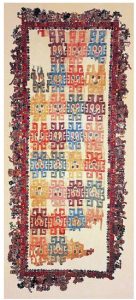
Roman amphitheater (El Jem, Tunisia)
The great empires formed during the last years before Christ continued peacefully through much of this period. In India, the Mauryan Empire collapsed. There was a period of smaller kingdoms. But by 319 AD northern India reunited under the Guptan Empire. In China, the Han Dynasty lasted until 220 AD, but then fell apart into three kingdoms. The world’s first smallpox epidemics may have weakened China. This time period is the subject of the Chinese novel Romance of the Three Kingdoms.

A cotton and alpaca wool cloth from Peru, about 200 AD (in the Brooklyn Museum)
On the other side of the Pacific Ocean, the Maya and the Zapotec continued to rule Central America. In South America, the Moche controlled most of Peru. The Mapuche lived in Chile and the Guarani in Paraguay. The Hopewell culture along the Mississippi River in North America also lasted all through this period.

Han Dynasty bell player (Portland Art Museum, Oregon)
Across the Atlantic, the Roman Empire and the Parthian Empire kept the peace throughout Europe, North Africa, and West Asia (when they weren’t fighting each other). Like China, these empires were suffered serious smallpox epidemics, but they kept going. In Egypt, textile manufacturers invented knitting. In northern Europe, even the Ostrogoths and Visigoths began to organize into leagues.
Further south in Africa, the kingdoms of Kush and Aksum, south of Egypt in Sudan and Ethiopia, traded with Rome, India and the Parthian Empire. The Bantu continued to expand across East and South Africa, bringing iron with them.
The long peace made travel and trade easy. Many new inventions and ideas spread across Europe, Asia, and Africa. Paved roads helped people travel. Paper, invented in China, was soon in common use across East Asia. Blown glass, invented in Roman West Asia, spread both east and west. Building in concrete and bricks, mastered by the Romans, soon spread across Europe, North Africa, and West Asia.

One of the earliest drawings of Jesus – here he is healing a man who was paralyzed. Now he gets up and carries his own bed. (Dura Europos, Syria, ca. 232 AD)
People and ideas also traveled across Afro-Eurasia with the peace. Dispersed by the Romans, the Jews spread all over Europe, North Africa and West Asia. Christianity spread from one end of the Roman Empire to the other, and to the Goths in northern Europe. Many people became Christians in East Africa, West Asia and Central Asia too, though most people stayed Zoroastrians or Buddhists. Nor was the religious flow all in one direction. Many Romans also became interested in Mithra, a Zoroastrian god.